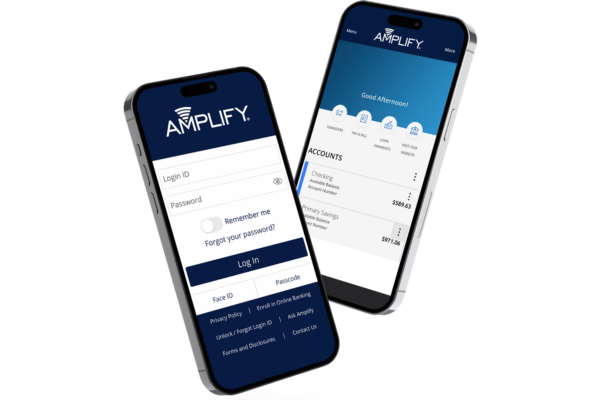Guide to Bank Fees
Is your financial institution nickel-and-diming you every month? Amplify members enjoy fee-free banking–no overdraft fees, no mystery charges.
At Amplify, every member enjoys fee-free banking—that means no mystery charges, no random service fees, and no guesswork. Read on to learn more about common bank fees and how to avoid them.
Overdraft fees generated a whopping $31 billion in revenue for banks in 2020 – and that number doesn’t include service fees, ATM fees, minimum balance charges, and all the other random fees banks charge. A recent study estimates that consumers who are charged bank fees may be paying up to $19 a month – all just for having a bank account!
Here’s a not-so-secret fact about these fees: you shouldn’t have to pay them, and with Amplify, you never will. Amplify checking and savings accounts are fee-free! Our job is to improve the financial lives of our members – so we removed those unwanted charges that can have a big impact on your bottom line.
But to understand the why behind fee-free, here’s a little crash course in all the fees that some other institutions tack on. We want you to have the information and choices you need for financial success!
Monthly Maintenance Fee
What do monthly maintenance fees cost?
Some institutions charge a couple of dollars per month and some charge as much as $25. The current nationwide average monthly fee for checking accounts sits at an all-time high of $16.35, which means you could pay $200 per year—just for having an open account.
What is a monthly maintenance fee?
It’s true—some banks charge you just for having an account. Some institutions waive it if you meet certain conditions, like using your debit card a few times, having direct deposit, or having a certain amount in your account.
But here’s why you shouldn’t have to pay it: beyond the fee, financial institutions are already making money with your deposits. They are investing and profiting, and they’re using your deposit money to do it.
The best way to avoid monthly maintenance fees is to bank with an institution that doesn’t charge the fee at all. You could also choose a bank that offers to waive the fee and work to meet the requirements each month, but you’ll have to keep a close watch on how you’re using your account or debit card to make sure you meet their minimums.
Minimum Balance Fee
What does a minimum monthly balance fee cost?
Minimum balance fees can range from $5 to $25 or more.
What is a minimum balance fee?
You can be charged a minimum balance fee when your account balance dips below a certain amount. Some accounts have a minimum balance of just $5, but others can require you to keep at least $5,000 in the account to avoid getting charged.
If your balance falls below the specified amount, you’re hit with a fee. Some banks will charge this as soon as your balance dips, others may only charge it if your monthly average balance is below the amount.
To avoid a minimum balance fee, choose fee-free banking or choose an account with a low minimum balance. If your bank charges this, you’ll have to make sure your balance doesn’t dip too low.
Overdraft Fees
What do overdraft fees cost?
In 2021, nationwide overdraft charges hit an all-time high— $33.58 per overdraft transaction.
What is an overdraft fee?
An overdraft occurs when you swipe your card or write a check without having money in the bank to cover it. Rather than decline your card, the bank allows it to go through and charges a penalty. If you overdraft multiple times, even in the same day, they charge a fee every time you pay for something.
Overdraft fees happen mostly because of small purchases—according to the Consumer Financial Protection Bureau (CFPB), the median charge that leads to an overdraft fee is $24. The CFPB also report that 80% of the overdraft fees charged each year are paid by only 9% of customers. That’s a huge imbalance.
In other words, the people who are charged the most in overdraft charges are the people who can’t afford them to begin with. These fees can create a cycle of debt that is difficult to break.
You can avoid paying overdraft fees by looking for financial institutions that don’t charge them. Like Amplify, some digital banks and credit unions also offer overdraft protection programs that will temporarily cover transactions – all without charging fees. If you can’t switch banks right now, remember that institutions are required to allow you to opt-out of overdraft coverage.
Insufficient Funds Fee
What does an insufficient funds fee cost?
Insufficient funds fees typically run anywhere from $10 to over $40 per charge.
What is an insufficient funds fee?
Insufficient funds fees are similar to overdraft fees, but there’s a subtle difference. If your account doesn’t have enough in it, banks can choose to decline your card instead of letting your charge go through. In other words, the bank won’t cover what you need to buy, but they will charge a fee because you tried to buy something.
This fee can be tacked on to every charge that hits your account after the first time you’re declined. So if your account is lower than you think and you try to make several purchases, you can rack up over a hundred dollars in fees.
You can avoid insufficient funds fees in almost the same way as avoiding overdraft fees. Sign up for an account with a no-fee financial institution—or sign up for low-balance alerts and watch your account balance carefully.
Surprisingly, overdraft protection might actually be useful here: if your bank has a high insufficient funds fee but a lower overdraft protection transfer fee, opt into overdraft protection and keep a side account with extra cash.
Open an Account
Start your fee-free journey by opening an Amplify account. Save more with fee-free banking!

Return Check Fee
What does a return check fee cost?
The fee for a returned check can range from $25 to $40 per returned check.
What is a return check fee?
A returned check— also known as a bounced check— is a check that a bank declines to pay. A check can be returned because it’s too old, the check was disfigured, or because it’s missing critical information.
Checks can also be returned because an account lacks sufficient funds. In this case, your bank might charge you a return check fee and an insufficient funds fee.
We might sound like a broken record, but you can avoid getting charged by choosing a bank or credit union that doesn’t charge this fee to begin with. Better yet—you could choose a financial institution that doesn’t charge any of the fees we’re covering! (We’re talking about us.)
Stop Payment Fee
What does a stop payment fee cost?
These fees are typically around $30.
What is a stop payment fee?
A stop payment happens when you request a check or recurring debit payment to be stopped.
There can be a lot of reasons to stop a payment, like if you realize your account doesn’t have enough money in it, or you accidentally mailed a check to the wrong place.
If a bank stops a payment, they’ll charge you a fee.
There’s really only one way to avoid this one: choose Amplify or another financial institution that doesn’t charge this fee at all.
ATM Transaction Fee
What does an ATM transaction fee cost?
If you go outside your bank’s ATM network, you can be charged with fees that range anywhere from $1.50 to $6. In 2020, the national average for ATM fees was $4.72 per transaction.
What is an ATM transaction fee?
Typically, you won’t be charged for using own financial institution’s ATMs. You might even have a shared ATM network that allows you to withdraw cash from a lot of different ATMs.
But when you go outside of your financial institution’s network, there are two types of ATM transaction fees that may apply: the ATM operator fee and your bank’s non-network fee.
- Your bank’s non-network fee: This is charged by your own bank for using an ATM outside of their network. (We don’t charge our members this fee.)
- ATM operator fee: When using an ATM outside your bank’s network, the bank or company that operates the machine will also charge you a separate fee. (While Amplify no longer has non-network fees, ATM operator fees are outside of our control.)
When you choose fee-free banking, you get access to your own cash and you avoid ATM fees.
Service Charge
What does a service charge cost?
Service charges can range from $3 per month to over $25.
What is a service charge?
Some banks charge this fee instead of a monthly maintenance fee or on top of a monthly maintenance fee. An institution might waive this fee if you meet certain criteria.
The best way to avoid service charges is to use accounts that don’t come with these fees. You shouldn’t have to pay $300 a year to be taken care of.
Wire Transfer Fee
What does a wire transfer fee cost?
Domestic wire transfer fees are hefty—they can cost between $10 and $30. International wire transfers cost between $45 and $60.
What is a wire transfer fee?
A wire transfer is a method of electronic funds transfer from one account to another. Wire transfers are still used by banks and transfer service agencies around the world.
Domestic wire transfers are those made within the United States. International wire transfer fees apply if you send money outside of the country. A lot of people are now using services like Venmo or PayPal instead, but not everyone has these options.
Avoiding wire transfer fees isn’t easy—unless you have fee-free banking. Choose a credit union or bank that offers this service for free! You can also try alternative ways to send money, but not everyone accepts them—like your landlord or your mortgage lender.
Join the Amplify Community
Amplify members enjoy fee-free banking. No more overdraft fees, no more unexpected charges. Set your spending free!

Account Closing Fee
What does an account closing fee cost?
Account closing fees can be anywhere from $10 to $30.
What is an account closing fee?
Yup, some banks will even charge you for closing your own account.
This fee typically applies if you close your account within 90 to 180 days of opening it. The fee is an attempt to encourage loyalty to an institution and discourage people from opening an account just for sign-on benefits.
You may have guessed—you can avoid this fee by choosing a credit union or bank that doesn’t charge it at all. You can also keep your account open beyond the requirement—but what other fees is that account about to charge you?
Return Mail Fee
What does a return mail fee cost?
This fee could cost you from $2 to $15.
What is a return mail fee?
If letter from the bank (like tax documents or bank statements) are sent back marked “return to sender”, you could get hit with a return mail fee.
Letters from your bank can contain sensitive information, so they want to make sure it gets in the right hands. This fee is designed to cover the cost of handling returned mail and tracking down new addresses.
To avoid this fee by banks or other businesses, always be sure to update your address when you move. This will ensure that banks have your current address on file and send relevant documents to the correct location. While updating your address is a critical step everyone should follow, you can also look for an institution that won’t charge that fee at all (like Amplify!).
Debit Card Replacement Fee
What does a debit card replacement fee cost?
Debit card replacement fees can run between $5 and $10. Expect to pay more if you need rushed delivery—closer to $15 or $20.
What is a debit card replacement fee?
Most of us have lost our debit card at one point or another. When a bank charges you to replace your card, it might not matter to them whether you lost your wallet or had your card stolen—you’ll have to pay either way. Just to get access to your cash!
Not all financial institutions charge this fee. But if they do, it may be unavoidable. If you can wait for a replacement, you might be able to save some money by choosing the cheapest shipping option.
Make it easier on yourself—you can avoid this fee by choosing a credit union or bank that doesn’t charge you for replacing your debit card.
Paper Statement Fee
What does a paper statement fee cost?
This fee can be anywhere between $1 to $6—and you’re charged every time you get a paper copy of your bank statements.
What is a paper statement fee?
Paper statement used to be the only option, and it was standard practice for financial institutions to mail bank statements each month to all of their customers. With the rise of digital banking, it became easier (and much faster) for people to access their accounts online, and most banks and credit unions have stopped sending monthly statements.
If you need a paper statement, for proof of income or any other reason, some banks charge a fee for every time one is sent. This is to cover costs associated with paper, printing, and postage and encourage customers to go green and reduce waste.
You can avoid this fee by opting-in to paperless statements or by choosing fee-free banking.
Foreign Transaction Fee
What does a foreign transaction fee cost?
Foreign transaction fees can be a set fee ($5 to $10) or a percentage of the transaction (between 1% to 3% of the transaction amount).
What is a foreign transaction fee?
It’s all in the name—every time you pay for something with foreign currency or in a foreign country, you might get charged this fee.
What does this look like in real life? Paying for a croissant during your vacation in France could cost you an extra $10. Ordering something from Japan using yen could cost you even more, depending on what you’re ordering. Any time you purchase something outside of the US or without US currency, you could be charged.
The easiest way to avoid it? Last one, we promise: choose a financial institution that doesn’t charge this fee! Roam free.
Go Fee-Free With Amplify
The worst part about this whole list? Banks who charge these fees make it your responsibility to avoid them. One mistake – an accidental withdrawal or a simple misunderstanding – can mean hundreds of dollars’ worth of random charges. And that is just plain wrong.
This is exactly why we went fee-free. At Amplify, we know that our credit union only succeeds when our members win – and absolutely no one gets ahead by paying expensive bank fees. Our checking and savings accounts are both fee-free, and that means no mystery charges, no random service fees, no guesswork. At the end of the day, it’s not about avoiding fees—it’s about keeping more of your own money.
Join Amplify
Every member enjoys fee-free banking—that means no mystery charges, no random service fees, and no guesswork. Open your checking and savings accounts today, and join the Amplify community!

Please refer to the Share Account Rate Disclosure, Certificate Account Rate Disclosure, and Beneficial Owner Disclosure for further information relating to the above products. See Business Fee Schedule & Rate Schedule for current rates and fees.